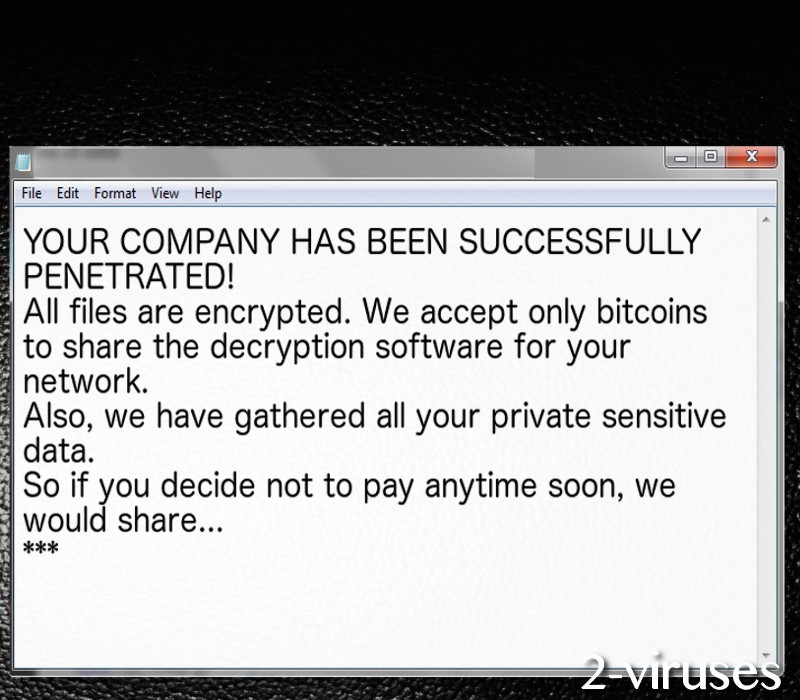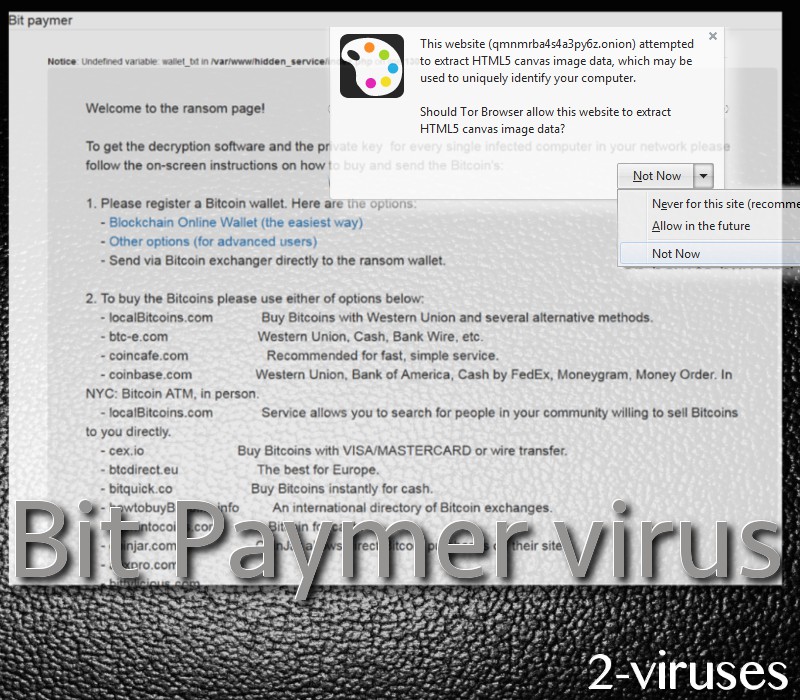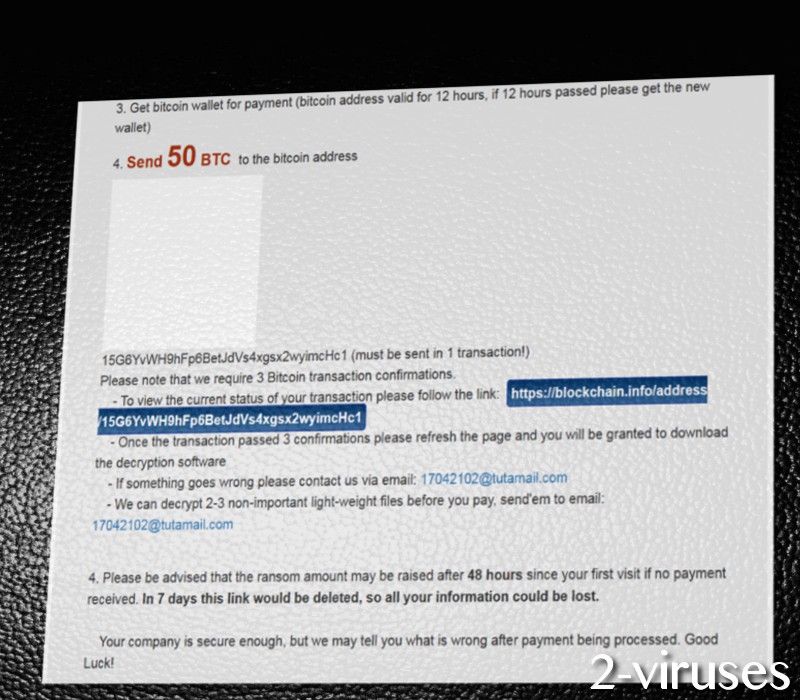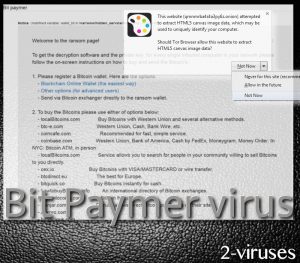BitPaymer ransomware virus has been crafted by especially greedy (and unrealistic) developers. Its payload has been determined to be DUe1bLM.exe.bin file which is proclaimed to belong to Microsoft Corporation which should automatically translate that this executable is a regular process for Windows operating system to feature. Most of the anti-viruses that detected this file to be suspicious/malicious, left references to assume that this crypto-virus might be related or be a newer version of Razy variant that we encountered in August of 2016. Gen:Variant.Razy.193441 is a common name that anti-virus used to indicate the fresh infection.
Symptoms of this ransomware infection
Furthermore, this newer ransomware sample operates with a TOR website Qmnmrba4s4a3py6z.onion which introduces victims with all of the requirements. Elementary information is provided in a .readme_txt file which briefly declares the fact that a crypto-virus has corrupted executables from the infected computer’s hard drive.

When victims visit the TOR website that hackers control, domain is presumed to require permission to extract HTML5 canvas image data. It is common for pages to ask for several configuration settings from your browser, but in this case, this shady TOR domain could fingerprint your browser. In other words, this technique will allow a unique identification of the visitor.

In the website that you will need TOR browser to access properly, you will find the useful information that hackers include into an explicit explanation of demands and ways of pursuing these requests correctly. While there was nothing absurd about the infection until now, we are about to provide you with some illogical demands that crooks decided to include. Victims are obliged to pay 50 bitcoins which is a ludicrous order. 116855.50 US dollars is the current sum which has to be paid to purchase such a number of bitcoins.

BitPaymer could be related with other crypto-viruses that have decided to append .locked extension to the data it encodes. There is no information, regarding the cipher that the ransomware exploits. But we do not expect it to be anything fancy: either AES or RSA algorithms. The creators are either not familiar with the bitcoin currencies or have too high expectations for their victims. The payload DUe1bLM.exe.bin extracts files, modifies auto-execute functionality by setting a value, initiates a number of processes, opens a file with deletion access rights and even marks which data should be removed.
File-recovery options
Currently, security researchers have not managed to create a free tool for file-recovery, but such a possibility should not be disregarded. Of course, time might not be victims’ friend: if hackers do not receive the demanded sum of money in their bitcoin wallet, they are threatening to increase the ransom. As if the fee is not impossible to pay already. After 7 days of no transactions from a victims, the authors of BitPaymer indicate that all of the data will be lost.
One of the other options that you can try are these. The first one refers to the possibility that this crypto-virus might have left Shadow Volume Copies undamaged. In that case, you could restore them. In addition to that, there are other tools for file-recovery that could help you. Nevertheless, the best option is that you remove the infection and retrieve files from alternative sources that contain your important digital data.
Online backup storages, USB flash drivers and other locations that you might find fit could be exploited for the purpose of securing data. If you have your stored files in a backup storage, then you should have no issue in retrieving files. Before that, we recommend that you detect and remove the infection itself. Manual removal is a possibility, but eliminating crypto-viruses is rather complicated. If you want a quick solution, scan your device with an anti-malware tool like Spyhunter or Plumbytes.
Bitpaymer Virus quicklinks
- Symptoms of this ransomware infection
- File-recovery options
- Automatic Malware removal tools
- How to recover BitPaymer virus encrypted files and remove the virus
- Step 1. Restore system into last known good state using system restore
- 1. Reboot your computer to Safe Mode with Command Prompt:
- 2.Restore System files and settings.
- Step 4. Use Data Recovery programs to recover BitPaymer virus encrypted files

Automatic Malware removal tools
(Win)
Note: Spyhunter trial provides detection of parasites and assists in their removal for free. limited trial available, Terms of use, Privacy Policy, Uninstall Instructions,
(Mac)
Note: Combo Cleaner trial provides detection of parasites and assists in their removal for free. limited trial available, Terms of use, Privacy Policy, Uninstall Instructions, Refund Policy ,
How to recover BitPaymer virus encrypted files and remove the virus
Step 1. Restore system into last known good state using system restore
1. Reboot your computer to Safe Mode with Command Prompt:
for Windows 7 / Vista/ XP
- Start → Shutdown → Restart → OK.
- Press F8 key repeatedly until Advanced Boot Options window appears.
- Choose Safe Mode with Command Prompt.

for Windows 8 / 10
- Press Power at Windows login screen. Then press and hold Shift key and click Restart.

- Choose Troubleshoot → Advanced Options → Startup Settings and click Restart.
- When it loads, select Enable Safe Mode with Command Prompt from the list of Startup Settings.

2.Restore System files and settings.
- When Command Prompt mode loads, enter cd restore and press Enter.
- Then enter rstrui.exe and press Enter again.

- Click “Next” in the windows that appeared.

- Select one of the Restore Points that are available before BitPaymer virus has infiltrated to your system and then click “Next”.

- To start System restore click “Yes”.

Step 2. Complete removal of BitPaymer virus
After restoring your system, it is recommended to scan your computer with an anti-malware program, like Spyhunter and remove all malicious files related to BitPaymer virus. You can check other tools here.Step 3. Restore BitPaymer virus affected files using Shadow Volume Copies
If you do not use System Restore option on your operating system, there is a chance to use shadow copy snapshots. They store copies of your files that point of time when the system restore snapshot was created. Usually BitPaymer virus tries to delete all possible Shadow Volume Copies, so this methods may not work on all computers. However, it may fail to do so. Shadow Volume Copies are only available with Windows XP Service Pack 2, Windows Vista, Windows 7, and Windows 8. There are two ways to retrieve your files via Shadow Volume Copy. You can do it using native Windows Previous Versions or via Shadow Explorer. a) Native Windows Previous Versions Right-click on an encrypted file and select Properties → Previous versions tab. Now you will see all available copies of that particular file and the time when it was stored in a Shadow Volume Copy. Choose the version of the file you want to retrieve and click Copy if you want to save it to some directory of your own, or Restore if you want to replace existing, encrypted file. If you want to see the content of file first, just click Open.
b) Shadow Explorer It is a program that can be found online for free. You can download either a full or a portable version of Shadow Explorer. Open the program. On the left top corner select the drive where the file you are looking for is a stored. You will see all folders on that drive. To retrieve a whole folder, right-click on it and select “Export”. Then choose where you want it to be stored.

Step 4. Use Data Recovery programs to recover BitPaymer virus encrypted files
There are several data recovery programs that might recover encrypted files as well. This does not work in all cases but you can try this:- We suggest using another PC and connect the infected hard drive as slave. It is still possible to do this on infected PC though.
- Download a data recovery program.
- Install and scan for recently deleted files.








